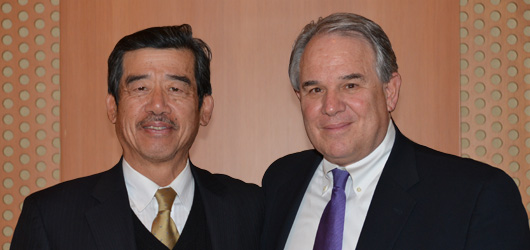
The Mayfield Education & Research Foundation and the University of Cincinnati Department of Neurosurgery were privileged to host Takeshi Kawase, MD, PhD, Professor in the Department of Surgery at Keio University in Tokyo, as the 2013 Keller Lecturer in Surgical Neuroanatomy & Research on Wednesday on the UC campus.
Dr. Kawase spoke about new approaches, and the history of those approaches, to tumors, aneurysms, and other malformations in the skull base. A pioneer in his field, he graduated from medical school at a time when angiography was infused by hand and when surgeons had no CT or MRI scans to guide them. “The brainstem was not visible until death,” Dr. Kawase recalled. “My concept was, ‘Do it yourself.’”“Dr. Kawase is well known to neurosurgeons and ear, nose and throat specialists throughout the world,” said Jeffrey T. Keller, PhD, Research Professor of Neurosurgery & Anatomy and Cell Biology at UC and the Mayfield Clinic. “Everyone knows the Kawase Approach [the anterior petrosectomy to the posterior fossa].”
The annual Keller Lectureship was established in 2012 by the Mayfield Foundation to honor Dr. Keller, who has been training surgeons, residents, and medical students in applied neuroanatomy since 1975.
Dr. Kawase has held leadership positions in the Japan Neurosurgical Society and Japan Skull Base Society, and he is a leader in the World Federation of Neurological Societies.
Dr. Kawase’s return to Cincinnati continued a collaboration between Mayfield and specialists from Japan that dates back to 1951, when, as a McArthur Fellow, Dr. Shigemaru Mikouchi traveled to the United States aboard a military ship named Young American to study neurosurgery with Dr. Frank H. Mayfield. The late Dr. Mayfield noted in a letter to the journal Neurosurgery in 1987 that, “At the conclusion of World War II, Dr. Eldridge Campbell, Colonel, U.S. Army Medical Corps, and Neurosurgical Consultant to General Douglas McArthur, persuaded the General to authorize Graduate Neurosurgical Fellowships in the United States for several young Japanese general surgeons.”
Dr. Mikouchi so valued his experience with Dr. Mayfield that he sent his nephew, Dr. Kensuke Kurokawa, to study with Dr. Mayfield, Stewart Dunsker, MD, and John M. Tew, Jr., MD, in 1972. The Japan-Mayfield legacy continued in 1992, when Dr. Kawase came to Cincinnati on an academic sabbatical to collaborate in skull base anatomy and surgery, and in 2002, when Dr. Kurokawa sent his son, Dr. Ryu Kurokawa, to study with leaders at the Mayfield Spine Institute. Earlier this year, Dr. Tew was an invited speaker at the Japan-American Neurosurgical Society meeting in Osaka and the Japan Spine Symposium in Hawaii.
Dr. Kawase is an artist in every sense of the word. “Like many great surgeons, he does his own drawings,” Dr. Keller noted. “After every surgery he takes the time to draw the surgery he has just completed.”
Dr. Kawase showed video footage of one of his surgeries, in which he removed a large meningioma tumor from the skull base of a 21-year-old man. The tumor enveloped arteries and cranial nerves. Like the artist he is, Dr. Kawase meticulously worked his way through the complex anatomy, protecting vital structures and removing, perfectly, the tumor. A photo of the patient showed the end result: a radiant smile and no facial palsy.
Dr. Kawase, who retired as Chairman of Neurosurgery at Keio University in 2009, today spends a good portion of his time and resources traveling to developing nations and helping them build their neurosurgical programs. “He is committed in spirit and financially,” Dr. Keller said.
“It is important for the neurosurgeon to keep three items in mind,” Dr. Kawase said. “Not only is the technique important; not only is the science important; but the heart is also important.”
— Cindy Starr